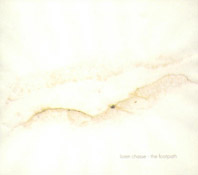: loren chasse
Naturestrip NS3007
www.naturestrip.com/

The work of American Loren Chasse can be largely characterised by his attentiveness to environments. This is what ties his work in with the myriad groupings of the Jewelled Antler collective and their idiosyncratic form of nature-bound acoustic psychedelia, often performed and recorded in outdoor settings, and his solo work that explores space, place and the act of listening through the use of location recordings. In this solo incarnation, Chasse’s work is closely associated with that particularly west coast group of sound-artists, which includes Brandon LaBelle, Jim Haynes and Steve Roden (all collaborators of Chasse over the years), who have explored a particularly post-‘industrial music’ notion of ambient sound making.
Environmental sounds form a major current in the history of music, a strong eddy of which has flowed through sonic experimentalism since the 20th century. However in the wake of this has come a range of issues about the conceptualisation, mediation and representation of the sounds of the natural, physical world within aesthetic projects. Where often the material manipulation and editing of these sound sources by artists can deflate what might otherwise be taken for a plea for naturalism (or indeed realism), much of the rhetoric that surrounds these practices drifts towards the essentialist, in that recordings are posited as somehow capable of relaying phenomenological aspects of actual places and environments along with the listening experiences that might occur within them.
Some of these issues come to the fore on The Footpath. The text accompanying the disc describes the sensations experienced during an afternoon spent on foot, pondering the sources of sounds heard and their locations. This text relates closely to “Arbor Pores”—a work in three tracks that forms two fifths of the album’s running time—which is constructed from recordings made in outdoor settings, and is to varying degrees a successful attempt to evoke the feeling and impression of a place or space.
More problematic is “Footpath Apparitions” which comprises the majority of the album. Edited from recordings of performances in Europe and America, environmental recordings are simply one component within a more overtly musical scheme. Here Chasse seems to prefer a palate composed of deep, muffled reverberances for conveying notions of depth and spaciousness, and along with the incorporation of melodic fragments (whatever their source), effects and winding drones, they tend to render the recorded locations as but one texture among many. The oceanic pace and fade-in fade-out edits—all too familiar hallmarks of much contemporary sound art—unfortunately tend to move the work towards the ponderous rather than the sonorous.
Then again, “Footpath Apparitions”, rather than evoking the sensations of the field recordings used in its construction, or of the live context in which they were later performed, perhaps best represents the difficulty of the practice of giving preference to the sounds of the environment: how to impart that which is ever present—the sounds, experiences and places of the physical world—which are yet under-heard. To this end the more straightforward approach of ‘”Arbor Pores” is telling, if perhaps to some ears less inviting.
Peter Blamey






